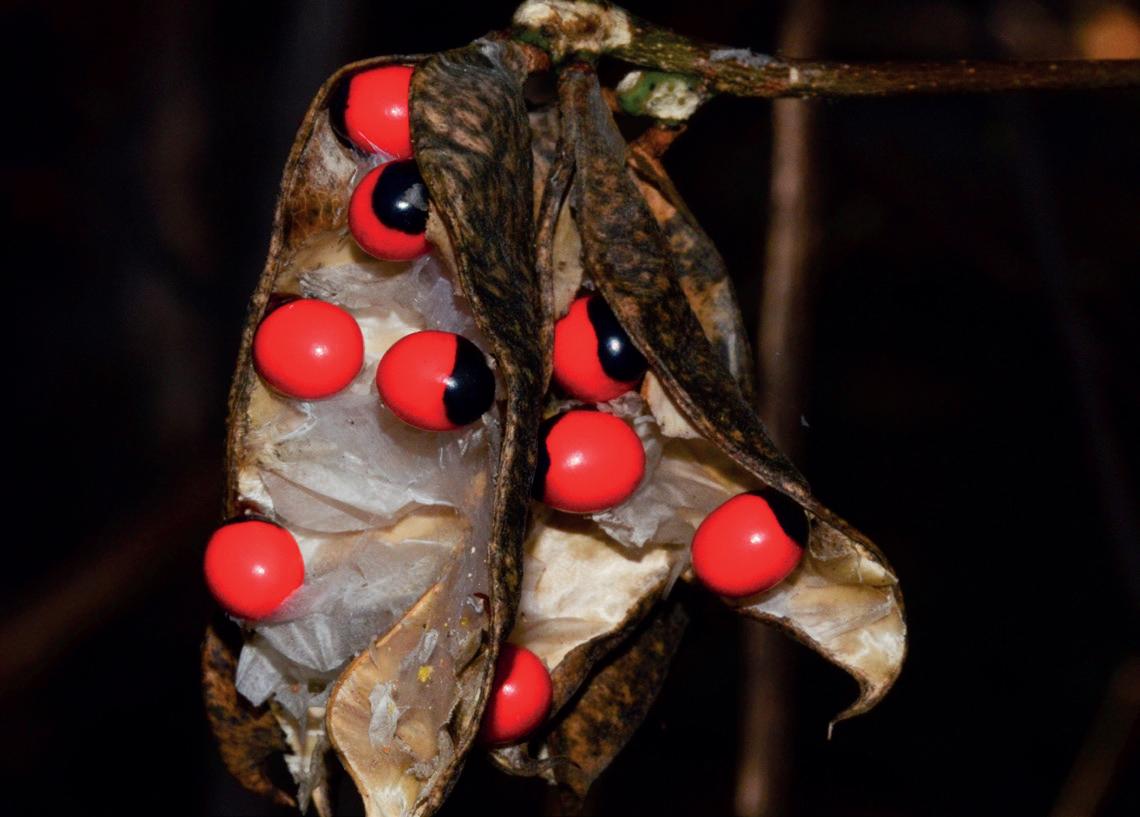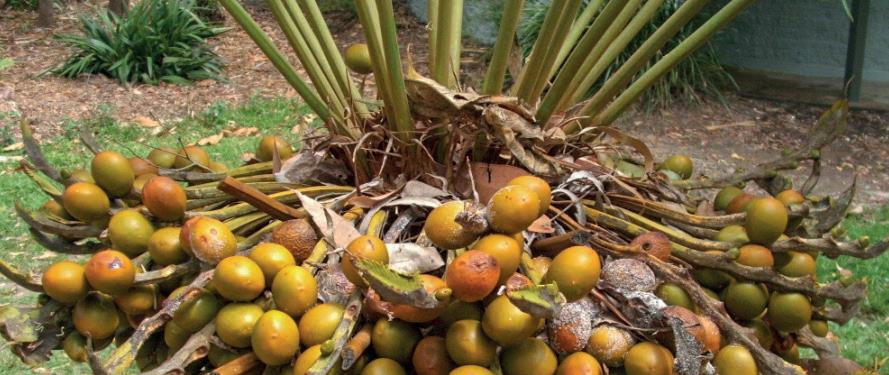
6 minute read
Pages

Poisonous seeds of the Crab’s Eye Vine Abrus precatorius Black Bean fl owers Castanospermum australe




‘Blind-your-eye’ Mangrove male fl owers Excoecaria agallocha Black Bean seed pods, Castanospermum australe, are poisonous



Poisonous seeds of a Cycad Cycas sp.



Tar Tree Semecarpus australiensis fruit with swollen orange stem Native Frangipani Cerbera manghas

Black sap and fruit of Tar Tree, Semecarpus australiensis on a footpath near the Cairns Botanic Gardens. The tree has since been removed.
Toxic plants in the Wet Tropics

TOM COLLIS
Some very toxic plants are found in the Wet Tropics. The toxins can be in new foliage, sap, fruits, seeds, or in some cases, throughout the whole plant. One of these toxic plants is the Tar Tree, Semecarpus australiensis. This large rainforest tree produces fruit with an orange-coloured swollen stalk attached to the fruit, similar to cashew nut, a close relative. Extremely toxic sap from the fruit and other parts of the tree blacken when exposed to air. Many people have severe allergic reactions to the sap including dermatitis, blistering of the skin and even temporary blindness. The poison in the Tar Tree has been identifi ed as urushiol, the same toxin found in Poison Ivy, Toxicodendron radicans. Tar Trees can be seen in the Cairns Botanic Gardens and several other parks around Cairns. Some trees have been removed for public safety reasons. Another poisonous plant is the Native Frangipani, Cerbera manghas. All parts of the plant are poisonous, particularly the unripe fruit. Eating the seeds of this fruit can result in vomiting, diarrhoea, drowsiness, slow heartbeat and even death. A very potent drug, cerberin, has been extracted from the seeds. Cerberin has a similar eff ect on humans to digitalis – a drug used in medicine to slow the heartbeat. Other parts of the plant are less toxic although the white latex can irritate the skin and eyes. Native Frangipani is a diff erent plant to the well-known Frangipani, Plumeria, a popular introduced tree with perfumed fl owers. The Crab’s Eye Vine or Gidee Gidee, Abrus precatorius, is commonly found in the coastal vegetation around Cairns. The vine produces pods with attractive, bright red and black seeds. The seeds are extremely poisonous with enough toxin in a single seed to kill an adult if chewed and ingested. The attractive seeds are occasionally used as beads in necklaces and bracelets, but wearing these objects may not be safe as toxin from the seeds could be absorbed through the skin. In the mangroves, the Milky Mangrove, Excoecaria agallocha, has an alternative common name – ‘Blind- your-eye’ Mangrove. The caustic milky sap is known to cause temporary blindness and can blister the skin. This is another tree best avoided. There are several toxic plants in the rainforest that Aboriginal people eat, but only after treatment to remove the poisons. One of these is the Black Bean, Castanospermum australe, easily recognised by the attractive orange fl owers and large seed pods that hang from the branches. Aboriginal people roasted the large seeds and then leached the toxins in running water for several days before pounding them into fl our to cook in a similar way to damper. Similar methods were used to treat the poisonous seeds of several Cycas species before eating. Great care should be taken before tasting any fruit or plant in the Wet Tropics. Several years ago a botanist on the Atherton Tableland tasted a very small piece of a seed from a rainforest plant called Spice Bush, Triunia erythrocarpa – a plant related to Macadamia with a common name that suggests edibility. Despite the pleasant taste of the seed the botanist was soon in a serious condition in the Atherton Hospital. The toxin in the fruit slowed his heart rate to a dangerously low level that could easily have been fatal. Several other Wet Tropics plants are toxic so do not risk tasting any unfamiliar fruits. A dangerous myth about native plants is that if a bird is seen eating a native fruit it is safe for humans to eat. However, many native birds have diff erent digestive systems and physiology and can eat plants that are highly toxic to humans.
Nordmann’s Greenshank (aka ‘Nordy’) hunting / chasing prey. Photo: Norton B Gill

Rare visitor to Cairns foreshore - Nordmann’s Greenshank
Jennifer H. Muir
Something special happened on the Cairns foreshore over 2020/21 new year. It was the arrival of one of the world’s rarest and most threatened migratory shorebirds: a Nordmann’s Greenshank (Tringa guttifer – referred to as ‘Nordy’ in this article). This species is classified in the IUCN Red List as Globally Endangered, due to its overall low population and restricted range. With a world population of less than 1,000 and decreasing, this species is under threat of global extinction. Such low numbers of individuals in a species is a potential disaster for that species as variation in the ‘gene pool’ is much reduced by the low numbers. Offspring in small populations receive less gene variation, and are thus more vulnerable to disease and other negative impacts they might otherwise be able to overcome. Nordmann’s Greenshank often occurs in mixed flocks with Common Greenshank (T. nebularia), as our Nordy did in Cairns, and many people find the two species difficult to differentiate. Nordman’s Greenshank looks more ‘bull-headed and burly’ with shorter, more yellowish legs, and thicker bi-coloured bill, olive-green at the base darkening towards the tip, than Common Greenshank which is tall and elegant and its legs more greenish. It’s believed our Nordy was probably blown off course, or arrived in Cairns with other migrant species, during its migration south to avoid the severe Northern Hemisphere winter. Many birders came to Cairns from other parts of Queensland and interstate to see Nordy, gathering along the foreshore in sometimes large groups with spotting scopes and cameras. The Cairns region is a recognised world hot-spot for birds: over half of Australia’s bird species are found in tropical North Queensland. Many international birders have come here over the years: many extending their birding to Cairns Highlands/Atherton Tablelands and Cape York Peninsula. So, what is migration? A migratory species does regular, usually seasonal, geographical movements to another location, usually in response to food availability, later returning to the place from which it left. Most migratory shorebirds breed in the Northern Hemisphere in summer, but as the winters there are so severe and food extremely scarce, many fly long distances southwards (some even 25,000kms) to feed during the Southern Hemisphere summer in Asia and Australasia, returning northwards at the change of season. Nordy migrates from east Russia’s Pacific Coast via China, Korea and Japan to winter in South-east Asia:










